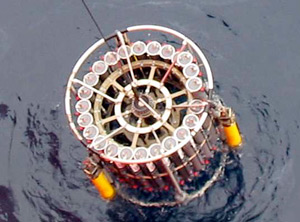Please note: You are viewing
the unstyled version of this website. Either your browser does not support CSS
(cascading style sheets) or it has been disabled. Skip
navigation.
Andrey ProshutinskyAugust 28-30, 2003Throughout the cruise, our chemistry team (from the Institute of Ocean Science in Canada and the International Arctic Research Center in the USA) has been measuring seawater properties and obtaining seawater samples for chemical analysis, most recently along 75°N latitude. In the following text, Fiona Mclaughlin (who communicates with us every day from Sidney, B.C.) and Valerie Forsland explain the major goals and methods of water analysis being conducted on this expedition: We are using a 24-bottle CTD/rosette to collect water column samples to investigate the origin and age of waters found in the Canada Basin. The rosette is lowered to the seafloor and then, as it is pulled upward, each 10 L bottle is closed individually to provide a sample from 24 different depths – reaching from the surface to as deep as 3800 m. When the rosette is brought back onboard the ship, a team of scientists from IOS and IARC are at-the-ready, anxious to get started with the sub-sampling. At a typical station there may be as many as 20 different sample containers to be filled from each 10 L bottle, ranging in size from a 10 ml test tube to a 10 L carboy. The water from each rosette bottle is analyzed for a number of geochemical constituents and each tells a different story and helps us to understand how the large scale atmosphere-ocean system works. Some of the geochemical tracers are being analyzed onboard ship and some are returned to laboratories in Canada, Japan and the US. One of the many questions we are asking on this expedition is whether the strength and location of the Beaufort Gyre affects the storage of freshwater. And, from an oceanographic point of view, freshwater refers to more than river or ice-melt water. For example we will be calculating the freshwater content at every station by integrating the difference in salinity we measure by comparing it to a reference salinity of S=34.8. In addition to salinity, we are also collecting samples for barium and oxygen isotope (δ18O) analysis. Barium tells us whether surface waters originate from the Mackenzie River, the largest Canadian river that flows into the Arctic Ocean; δ18O tells us how much of the freshwater is due to the melting of ice; and it is important to distinguish between these two different sources of freshwater when investigating questions about climate change. We are also investigating the carbon cycle and how greenhouse gases such as carbon dioxide are dissolved in the ocean and buried for periods of time. We are collecting alkalinity and total carbon dioxide samples from 4 different regions of the Canada Basin and δ13C in surface waters at all stations to investigate the role that the Canada Basin is playing in the global climate system. Plankton are also another part of the carbon cycle – the organic part – and we are filtering waters of the upper ocean to find out how much life is present. We are interested in knowing how old waters of the Canada Basin are – and by old we mean how long it has been since they were last in contact with the atmosphere. Samples for CFC (freon11,12 refrigerant), helium, tritium (3H) and δ14 C measurements provide information on different timescales – 2- 65 years for CFCs and He/3H and hundreds of years for δ14 C. Waters of the deep Canada Basin are believed to be 400-600 years old, dating back to the time of Columbus. We are curious to discover if deep waters in the Canada Basin are all this old. Geochemical tracers help us identify the source and circulation pathways of the two principal water masses found in the Canada Basin. Pacific-origin waters are fresher and contain more nutrients - silicate, nitrate, and phosphate - than the warmer and saltier Atlantic-origin waters. Atlantic-origin waters also carry higher values of radionuclides such as 129I and 137Cs than Pacific-origin waters. These radionuclides are by-products of nuclear re-processing plants in France and England and enter the Canada Basin via the Norwegian Coastal Current and Fram Strait. We are interested in where the boundaries between Pacific and Atlantic-origin waters are situated and how these locations vary over time. Various phytoplankton species coexist in the ocean but they are roughly characterized by size. We are investigating the vertical distribution of the phytoplankton in 3 size fractions (0.7-2um, 2-10um and >10um) in the Canadian Basin. As well, bongo net sampling – vertical tows - provides information regarding population density, species composition and DNA and molecular structure of Arctic zooplankton. Dissolved organic carbon (DOC), categorized into humic substance, carbohydrates, lipids, proteins and other minor components, is also important in the carbon cycle. A portion of total DOC, which absorbs light (CDOM), is used as a tracer for land/shelf interaction. CDOM and DOC are measured to track freshwater in the Beaufort Gyre. Last updated: October 7, 2019 | |||||||||||||||||
Copyright ©2007 Woods Hole Oceanographic Institution, All Rights Reserved, Privacy Policy. | |||||||||||||||||



